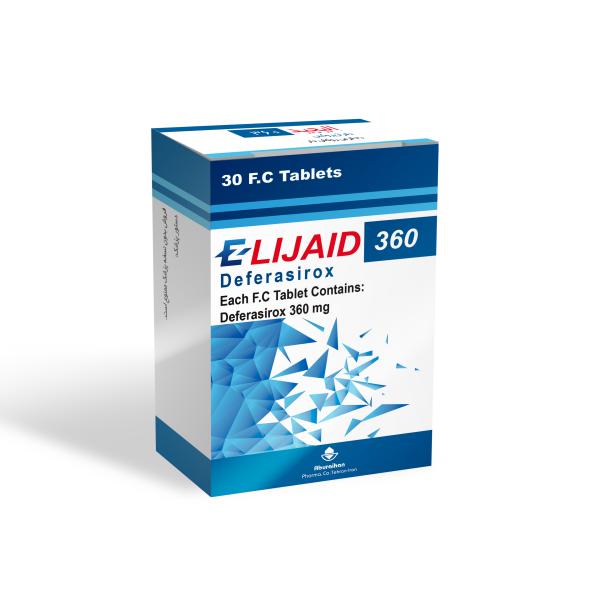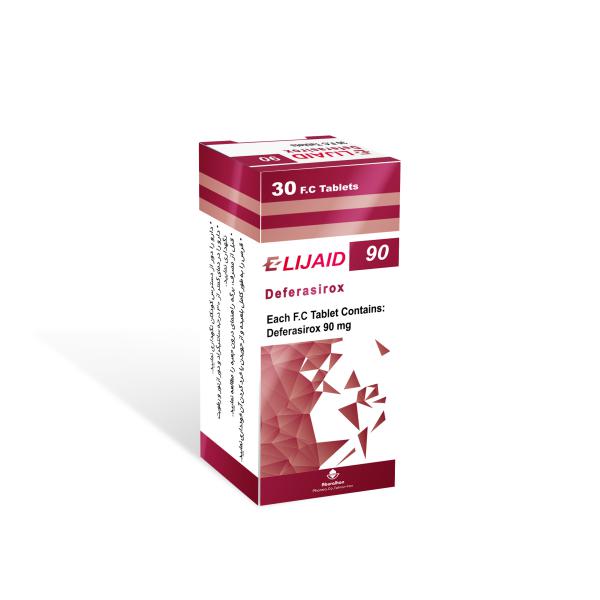Elijaid®
Deferasirox
Tablet 90 – 180 – 360 mg
- Elijaid® is an iron chelator indicated for the treatment of chronic iron overload due to blood transfusions in patients 2 years of age and older
- Elijaid® is indicated for the treatment of chronic iron overload in patients 10 years of age and older with non-transfusion-dependent thalassemia (NTDT) syndromes, and with a liver iron (Fe) concentration (LIC) of at least 5 mg Fe per gram of dry weight (Fe/g dw) and a serum ferritin greater than 300 mcg/L.
Mechanism of Action:
Deferasirox is an orally active chelator that is selective for iron (as Fe3+). It is a tridentate ligand that binds iron with high affinity in a 2:1 ratio. Although deferasirox has very low affinity for zinc and copper, there are variable decreases in the serum concentration of these trace metals after the administration of deferasirox.
Method of Administration:
|
Disease |
Dose |
|
|
Transfusional Iron Overload |
Initiating Therapy |
The recommended initial dose for patients 2 years of age and older with eGFR greater than 60mL/min/1.73 m2 is 14 mg per kg body weight orally, once daily. Calculate doses (mg per kg per day) to the nearest whole tablet. |
|
During Therapy |
* Monitor serum ferritin monthly and adjust the dose, if necessary, every 3 to 6 months based on serum ferritin trends.
*Use the minimum effective dose to achieve a trend of decreasing ferritin.
* Make dose adjustments in steps of 3.5 or 7 mg per kg and tailor adjustments to the individual patient’s response and therapeutic goals.
* In patients not adequately controlled with doses of 21 mg per kg (e.g., serum ferritin levels persistently above 2,500 mcg/L and not showing a decreasing trend over time), doses of up to 28 mg per kg may be considered. Doses above 28 mg per kg are not recommended |
|
|
Iron Overload in Non-Transfusion-Dependent Thalassemia Syndromes |
Initiating Therapy |
*The recommended initial dose for patients with eGFR greater than 60 mL/min/1.73 m2 is 7 mg per kg body weight orally once daily. Calculate doses (mg per kg per day) to the nearest whole tablet.
*If the baseline LIC is greater than 15 mg Fe/g dw, consider increasing the dose to 14 mg/kg/day after 4 weeks. |
|
During Therapy |
* Monitor serum ferritin monthly to assess the patient’s response to therapy and to minimize the risk of overchelation. Interrupt treatment when serum ferritin is less than 300 mcg/L and obtain an LIC to determine whether the LIC has fallen to less than 3 mg Fe/g dw. * Use the minimum effective dose to achieve a trend of decreasing ferritin. * Monitor LIC every 6 months. * After 6 months of therapy, if the LIC remains greater than 7 mg Fe/g dw, increase the dose to a maximum of 14 mg/kg/day. Do not exceed a maximum of 14 mg/kg/day. * If after 6 months of therapy, the LIC is 3 to 7 mg Fe/g dw, continue treatment at no more than 7 mg/kg/day. * When the LIC is less than 3 mg Fe/g dw, interrupt treatment with and continue to monitor the LIC. * Monitor blood counts, liver function, renal function and ferritin monthly * Increase monitoring frequency for pediatric patients who have acute illness, which can cause volume depletion, such as vomiting, diarrhea, or prolonged decreased oral intake. Consider dose interruption until oral intake and volume status are normal *Restart treatment when the LIC rises again to more than 5 mg Fe/g dw. |
|
Notes
Contraindications:
Estimated GFR less than 40 mL/min/1.73 m2, Patients with poor performance status, Patients with high-risk myelodysplastic syndrome (MDS), Patients with advanced malignancies, Patients with platelet counts less than 50 x 109/L,Known hypersensitivity to deferasirox or any component of Elijaid®
Interactions:
Do not take Elijaid® with aluminum-containing antacid preparations. Deferasirox increases the exposure of repaglinide. Consider repaglinide dose reduction and monitor blood glucose levels. Avoid the use of Elijaid® with theophylline as theophylline levels could be increased. Deferasirox increases exposure of busulfan. Monitor plasma concentrations of busulfan when coadministered with deferasirox to allow dose adjustment of busulfan, as needed.
Pregnancy and Lactation:
PREGNANCY: There are no studies with the use of Elijaid® in pregnant women to inform drug-associated risks.
LACTATION: No data are available regarding the presence of Elijaid® or its metabolites in human milk, the effects of the drug on the breastfed child, or the effects of the drug on milk production.
Warning and Precaution:
Acute Kidney Injury: Measure serum creatinine in duplicate before starting therapy. Monitor renal function during Elijaid® therapy and reduce dose or interrupt therapy for toxicity, Hepatic Toxicity: Monitor hepatic function. Reduce dose or interrupt therapy for toxicity, Fatal and Nonfatal Gastrointestinal (GI) Bleeding, Ulceration, and Irritation: Risk may be greater in patients who are taking Elijaid® in combination with drugs that have known ulcerogenic or hemorrhagic potential, Bone Marrow Suppression: Neutropenia, agranulocytosis, worsening anemia, and thrombocytopenia, including fatal events; monitor blood counts during Elijaid® therapy. Interrupt therapy for toxicity, Age-related Risk of Toxicity: Monitor elderly and pediatric patients closely for toxicity, Hypersensitivity Reactions: Discontinue Elijaid® for severe reactions and institute medical intervention, Severe Skin Reactions including Stevens-Johnson syndrome (SJS), toxic epidermal necrolysis (TEN), and drug reaction with eosinophilia and systemic symptoms (DRESS): Discontinue Elijaid®.
Adverse Reactions:
In patients with transfusional iron overload, the most frequently occurring (greater than 5%) adverse reactions are diarrhea, vomiting, nausea, abdominal pain, skin rashes, and increases in serum creatinine. In deferasirox-treated patients with NTDT syndromes, the most frequently occurring (greater than 5%) adverse reactions are diarrhea, rash, and nausea.
Storage:
Store below 30ºC and protect from light and moisture.



